Tag Archive: Safe driving
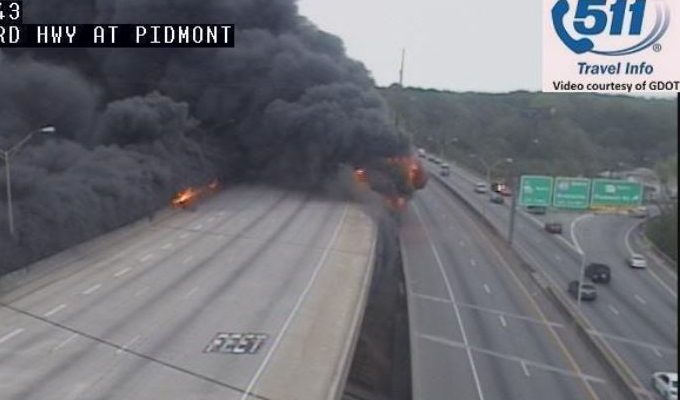
To My Friends In Atlanta
March 31, 2017
The City of Atlanta suffered a crippling fire yesterday that’s going to tie up traffic in the area for months to come. A large plastic tubing storage area underneath a bridge on Interstate 85 near downtown Atlanta caught fire and the resulting heat weakened the bridge structure causing it to collapse.
Highway officials and engineers say the damage isn’t limited to just the section of bridge that collapsed but also to adjacent roadways. The bridge collapse has shut down a major artery into downtown Atlanta that carries hundreds of thousands of cars each day. Since there’s no idea yet on the extent of the damage, there’s no word on how long repairs will take. Needless to say, Atlanta traffic is going to reach even greater nightmarish levels over the coming days and months.
In past articles, I’ve written nostalgically about my early days learning to drive in the City of Atlanta. For a while, I even worked as a tour guide, driving passengers in a small bus to all the interesting sights in and around the city. In those days, Atlanta drivers took great pride in their courtesy to each other. In fact, my tourists used to comment on how courteous the drivers were in Atlanta compared to their home cities. Those days are long gone!
The explosive growth of businesses in and around Atlanta brought millions of people from other parts of the country to Atlanta in search of jobs. The population of metro Atlanta swelled from just over a million people when I graduated from high school to almost six million today. Many of those transplants from other areas of the country brought their bad driving habits with them and the folks with bad driving behaviors soon supplanted the older, more courteous native Atlantans.
Their driving behavior became so bad that Atlanta is now listed among the top cities with the worst aggressive drivers and road rage incidents according to periodic surveys by AutoVantage, an online insurance company. In fact, Atlanta passed New York and Miami in the road rage rankings.
The collapse of the I-85 bridge is going to test Atlantans in ways not seen since General Sherman’s visit in 1864. If Atlantans stick to their current driving behaviors there’s going to be a lot of chaos on Atlanta roadways. There are going to be a lot more incidents of road rage, car crashes, and, unfortunately, a lot more deaths and injuries than normal.
The only way Atlantans are going to make it through this intact is if they fall back on those old fashioned driving behaviors exhibited by Atlantans many years ago. That means;
- obeying the speed limits,
- no tailgating,
- no cutting into the front of long lines of traffic,
- no trying to beat the yellow light,
- no running red lights, and
- keeping intersections clear.
It even goes so far as to mean allowing other drivers to enter the roadway ahead of you. Allowing another driver to enter the road in front of you costs very little time and will avoid those dangerous maneuvers by drivers trying to force their way into traffic.
If Atlantans were to try this radical new idea, they’d probably be very surprised to find that traffic will flow much more quickly and smoothly. It’s the smartest and safest thing to do. If not, they should run to their hairstylist, get a Mohican haircut, put on the spiked hubcaps, and mount the harpoons and mini-Gatling guns to the hoods of their vehicles because it’s going to be just like a Mad Max movie.
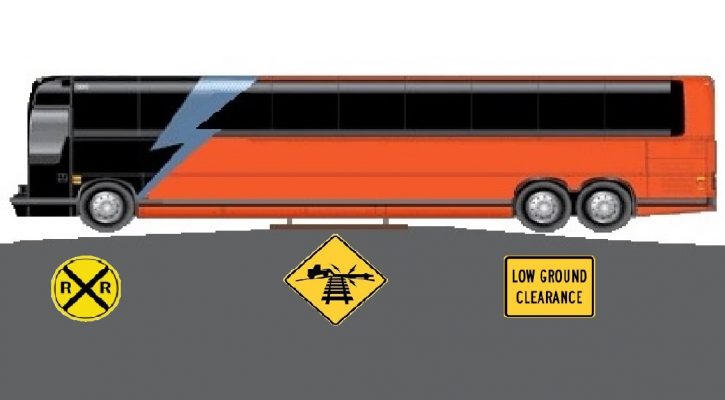
Pay Attention To RR Crossing Warning Signs!
March 8, 2017
All too often, drivers either ignore railroad crossing warning signs or assume the warning doesn’t apply to them. Yesterday, four people lost their lives and seven people were critically injured after a bus that was stuck on railroad tracks was hit by a train.
This wasn’t the first crash involving a stuck vehicle and a train at that railroad crossing. Just two weeks ago, a Pepsi delivery truck became stuck at the same crossing but, fortunately, no one was injured in that crash.
Many railroad grades have steep sides that make it dangerous for vehicles such as semi-trailers and buses that have very little ground clearance. Even some cars that have been modified can become stuck at these crossings.
One of the mistakes made in this instance was that the bus driver failed to immediately evacuate the bus as soon as he became stuck. Instead, a few people got off but most remained onboard while the driver tried to move his bus off the tracks. Had the bus been evacuated and the people moved far away from the tracks, the loss of life and injuries could have been minimized.
It’s important to remember that a fully loaded freight train carrying a lot of weight can take up to a mile before it can be brought to a complete stop. When approaching railroad crossings, look at and pay attention to all of the warning signs. If you think your vehicle may not make it across, turn back and look for another nearby crossing.
For more information visit: 4 dead after train, bus collide in Biloxi, Mississippi
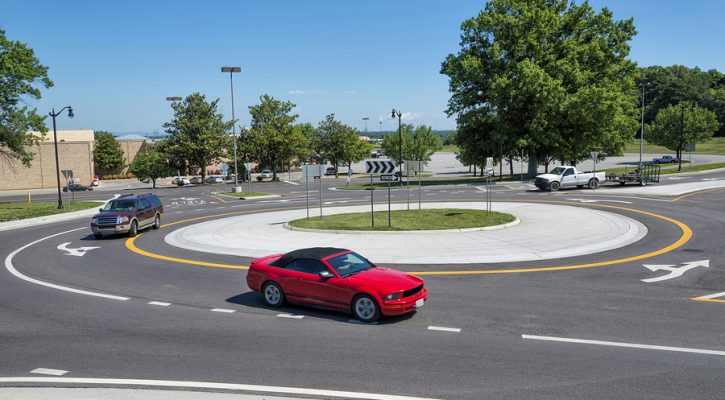
Replacing Signal Intersections With Roundabouts
November 10, 2016
By replacing their signaled intersections with roundabouts , Carmel Indiana, a suburb of Indianapolis, made a bold decision to spend more money up front in order to save a lot more money in the long run. While they were at it, they saved quite a few lives and prevented a lot of injuries.
Roundabouts are intersections designed to keep traffic moving more smoothly through intersections without the need for traffic lights. Roundabouts accomplish their mission by forcing traffic to slow down while allowing traffic from all directions to enter the intersection without having to stop. Since 2001, the city has built or replaced more than 100 intersections using roundabouts and there are plans to build even more. They hope to have the work completed by 2018.
Even though traffic is forced to slow when entering an intersection, it rarely has to stop. However, if a vehicle does need to stop while yielding to another vehicle, it doesn’t have to stop for long. The driver can enter the intersection as soon as traffic is clear without having to wait for a green light. Europe adopted roundabouts long ago and they’re becoming more common every year but the US didn’t adopt the idea until the 1990s and roundabouts here are few and far between.
By replacing their intersections with roundabouts, the city of Carmel saw dramatic results:
- Roundabout construction costs an average of $125,000 less than a signaled intersection.
- No more money is spent on maintaining or replacing traffic signals.
- Roundabouts don’t fail to operate when there’s a power outage.
- Without having to idle while waiting at a light, observations at ten study sites show an average gas savings of 24,000 gallons per year.
- Less gas used means less pollution.
- Each replacement intersection can handle a 30 to 50 percent increase in traffic flow.
- Less time spent in traffic means greater productivity.
- With all traffic going in the same direction, there are fewer serious crashes.
- Head-on and high speed right angle collisions are much less likely at roundabouts.
- Slower speeds give drivers more reaction and decision making time.
- Roundabouts are safer for pedestrians.
- Injury crashes were reduced by almost 80% at intersections replaced by roundabouts.
- Overall, crashes were reduced by 40%.
- Fewer crashes mean lower costs for first responders.
- Fewer crashes mean first responders can focus on other needs.
To save money and lives, more cities and counties need to consider following Carmel’s lead.
For more information, visit: City of Carmel Indiana
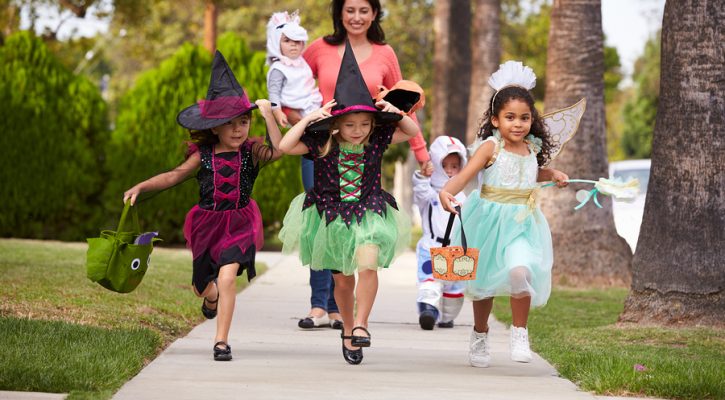
Holiday Driving: Halloween Safety Tips
October 28, 2016
The chill is in the air, orange is the dominant color and kids are beginning to think of their plans for Halloween. Before you go out shopping for costumes and buying bags of candy this year, consider a few safety tips and spend a few minutes planning for the night ahead.
- Identify what type of celebrations will be taking place and where they will be located. Not only will it help determine your plans, it will help you be an aware driver as you travel on the roadways. If you’re attending a party, plan for a designated driver or commit to not drinking. Even small amounts of alcohol can impair your judgment and driving. Driving under the influence can kill or cause trauma, be expensive and embarrassing.
- When costume planning, make sure that all costumes fit appropriately and won’t restrict movement or visibility, either as a pedestrian or behind the wheel. Ensure foot wear is sturdy. Tripping, falling, difficulty steering or braking can be dangerous!
- Add reflective tape to costumes and replace flash light batteries to ensure you will be visible, whether escorting trick or treaters or attending an event yourself. Make sure that any children you’re with have flashlights, glow stick, bright candy bags, and reflective tape on costumes as well. Clear up any yard obstructions, water hoses, and overgrown vegetation to make it easier to see and maneuver for both pedestrians and vehicles.
- Know your planned route, to avoid the unexpected. Plan to travel in well lighted areas. If walking, use sidewalks and crosswalks. If driving, avoid areas of heavy pedestrian traffic and park in areas with the greatest visibility. Select alternate routes that will provide the least amount of risk and the most amount of safety. Arrange to give yourself extra time to and from your destination.
- Know what night of the week Halloween falls on. If Halloween is on a weekend, expect the festivities to begin early in the day and prepare to be a defensive driver. If it is on a weeknight, children will be starting their rounds before the evening rush hour is over. Be especially watchful and, if you can, avoid driving on Halloween altogether.
- Be alert for kids playing in costumes during the day, darting from house to house or in between parked cars. Pay special attention beginning at 4:30pm for the younger treat seekers. Turn on your head lights to make your vehicle more visible. Dusk is the most dangerous time of day because lights and shadows can fool you so drivers need to be especially vigilant.
- Reduce distractions. Make sure your cell phone is on silent, your radio volume is low and your passengers are aware to minimize distractions and assist with being alert to the surrounding environment.
- Be extra cautious as you pull into and leave driveways, parking lots and alleys. Watch for children who may dart out between cars, at roadways, medians and on curves. Be sure to check your blind spots thoroughly and maintain a search and scan of the driving environment every few seconds.
- Travel well below the posted speed limit. Be extra patient with pedestrians and other vehicles and always be prepared to stop at a given moment. Other drivers may be distracted by the trick or treaters inside their vehicle and may not see you. Avoid passing or going around stopped vehicles. They may have passengers entering and exiting hurriedly and carelessly.
Halloween can truly be a fun night full of great memories! Take a few steps to keep it safe and trouble free.
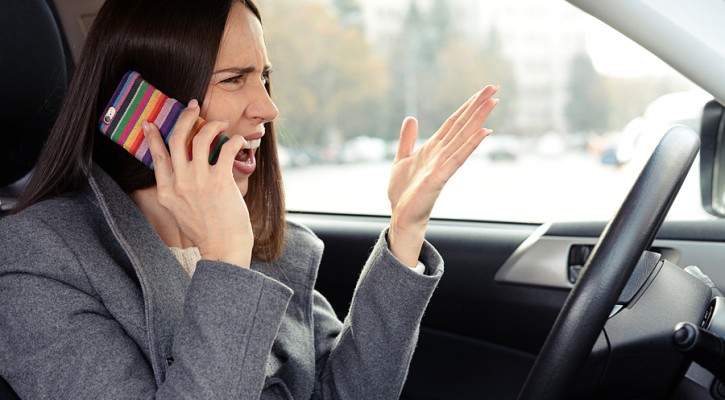
Strong Emotions Increase Crash Rate Tenfold
February 26, 2016
In 2006, the Virginia Tech Transportation Institute (VTTI) along with the National Highway Traffic Safety Administration (NHTSA) conducted a natural driving behavior study by outfitting 100 cars with sensors and cameras that observed both the driver and events outside the vehicle. Recently, VTTI added to that original study by conducting the largest study of its kind. In the latest study, VTTI followed more than 3,500 participants across six points in the US. The results showed that driver emotions are just as, if not more dangerous than driver distractions.
In the first study, the subject vehicles logged nearly two million miles and were involved in 761 near crashes and 82 actual crashes. The results showed that almost 80 percent of motor vehicle crashes and 65% of near crashes involve driver inattention within three seconds before the event.
In the second study, VTTI again outfitted driver’s personal vehicles with unobtrusive instrumentation, including a suite of cameras, sensors, and radar. The instruments continuously recorded real-world driver performance and behavior, from the time the drivers turned on the ignition to the time they turned the engine off. The drivers participated between one and two years each and accumulated more than 35 million miles of observable data.
Unlike the first study that looked at events and driver behaviors that led to both near and actual crashes, the second study only collected data on 1,600 actual crashes ranging in severity from low, such as striking the curb, to severe, police-reportable crashes.
Driving experts have known for years that driver emotions and attitude have the greatest impact on driving safety. This study was able to see that relationship in greater detail. According to the researchers, “drivers increase their crash risk nearly tenfold when they get behind the wheel while observably angry, sad, crying, or emotionally agitated.”
Where distracted driving is concerned, the researchers found that:
- Drivers engage in some type of distracting activity more than 50 percent of the time they are driving.
- Crash rates are doubled when drivers engage in distracting activities that require them to take their eyes off the road, such as using a handheld cell phone, reading or writing, or using touchscreen menus on a vehicle instrument panel.
It all comes down to basics; drive the car instead of letting your emotions drive you and avoid distracting behaviors at all costs.
To learn more read: Researchers determine driver risks using large-scale, crash-only naturalistic database
